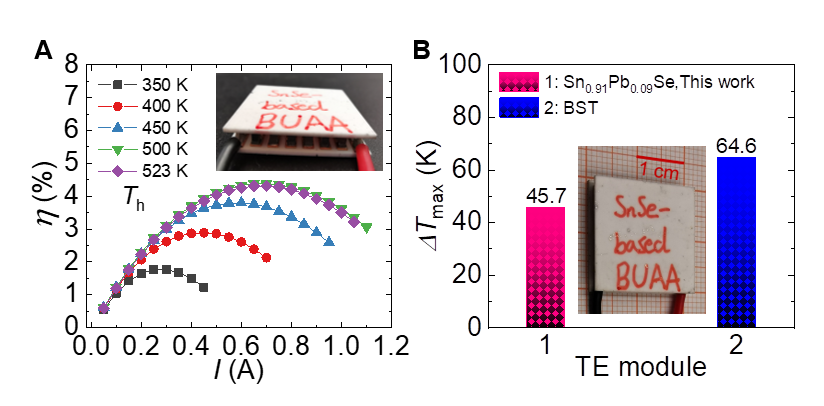On July 8, the latest findings on thermoelectric cooling materials and applications by Professor Zhao Lidong’s research group from the School of Materials Science and Engineering of Beihang University, titled “Momentum and energy multiband alignment enable power generation and thermoelectric cooling”, was published in Science as First Release and Full-text Research Article. Qin Bingchao, a doctoral student of Beihang University, is the first author, and his supervisor Zhao Lidong is the corresponding author.


In this work, the performance of p-type SnSe crystals is greatly improved by aligning multiband structures in both momentum and energy spaces. Moreover, a thermoelectric device based on SnSe material is fabricated, realizing both power generation and thermoelectric cooling. The results demonstrate the great potential of SnSe-based materials for thermoelectric cooling applications.
Recent studies have shown that by optimizing the effective mass m* and mobility μ, materials’ electrical transport properties can be continuously improved (PF = S2σ). This research mainly focused on how to synergistically optimize the mobility μ and effective mass m*, move the high-efficiency electrical transport characteristics to around room-temperature, and then achieve thermoelectric cooling.
In this research, the momentum and energy multiband alignment effect caused by the merging of multiple valence bands was observed in SnSe. As shown in Fig. 1, the momentum alignment corresponds to the merging process of the first and second valence bands, which effectively promotes the mobility μ and the electrical conductivity σ. Moreover, the energy alignment corresponds to the merged pudding-mold band (VBM (1+2)), experienced an energy convergence with the third valence band (VBM 3), which effectively enhances the effective mass m* and the Seebeck coefficient S. Through 9% Pb alloying, the momentum and energy multiband alignment effect is further promoted, and finally the ZT value and thermoelectric performance of p-type SnSe crystals are significantly improved.

Fig. 1. Multi-band alignment leads to ultra-high ZT values
Based on the high performance p-type SnSe crystals, this research carries out the fabrication of thermoelectric device, simultaneously characterizing the thermoelectric power generation and cooling performance, which is proved to be significant. As shown in Fig. 2A, the device based on P-type SnSe crystals can achieve a high conversion efficiency of about 4.4% at a temperature difference of about 210K, which is equivalent to the commercial bismuth telluride-based thermoelectric device at the same temperature difference.
As illustrated in Fig. 2B, the thermoelectric device based on P-type SnSe crystals is able to achieve a maximum cooling temperature difference of about 45.7 degrees, which can reach 70% of that of commercial Bi2Te3 devices. Compared with the commercial Bi2Te3, however, the cost of SnSe is reduced by about 54% and the weight by about 21%.

Fig. 2. (A) Thermoelectric power generation efficiency and (B) maximum cooling temperature difference of thermoelectric device based on p-type SnSe crystals
Co-participants in this work are Professor Li Jingfeng’s research group from Tsinghua University, Professor Tang Xinfeng, Professor Tan Gangjian and the researcher Liu Wei from Wuhan University of Technology, and Professor He Jiaqing’s research group from Southern University of Science and Technology.
This research was supported by the National Natural Science Foundation of China (NSFC), the National Key Research and Development Program of China, Beijing Natural Science Foundation, etc.
Since 2015, Professor Zhao Lidong’s research group has been focusing on the frontiers of international academics, and has published five articles in Science successively.
Links to the five articles published by Professor Zhao Lidong’s research group:
2016: https://science.sciencemag.org/content/351/6269/141
2018: https://science.sciencemag.org/content/360/6390/778
2019: https://science.sciencemag.org/content/365/6460/1418
2020: https://science.sciencemag.org/content/367/6483/1196
2021: https://science.sciencemag.org/content/early/2021/07/07/science.abi8668
Webpage of Professor Zhao Lidong’s research group:
http://shi.buaa.edu.cn/zhaolidong/zh_CN/index.htm
Reported by Liang Weitao
Reviewed by Ma Zhaoli
Edited by Jia Aiping
Translated by Zang Mingming and Lyu Xingyun

